 |
 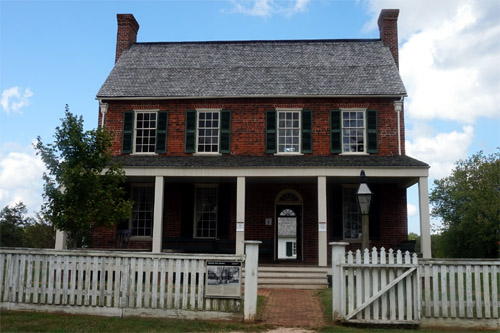 The Clover Hill Tavern, the oldest building standing in the Appomattox Court House National Historical Park. Click here to see the informational sign on the fence. The Clover Hill Tavern, the oldest building standing in the Appomattox Court House National Historical Park. Click here to see the informational sign on the fence. |
 |
Appomattox County was formed in 1845, by stealing bits of Buckingham, Campbell, Charlotte and Prince Edward Counties, jamming them together and then naming the reconstituted whole after the Appomattox River, which had been named for the local Appamatuck Indians.
The Clover Hill Tavern had been operating on the Richmond-Lynchburg Stage Road (which had been initiated circa 1790) since 1819, and it shortly grew its own separate kitchen and guest house. Given that there wasn't a whole lot else in Appomattox County when it was formed, the Virginia legislature figured that the tavern would be a swell place at which to locate the new county's seat. The courthouse was built across the street from the tavern in 1846.
Though it was (and is) a lovely courthouse, it played no role in the event that made it so famous: On April 9, 1865, Robert E. Lee surrendered the Army of Northern Virginia to Ulysses S. Grant at the McLean House, a few hundred yards to the east of the courthouse...which event essentially ended the Civil War. |
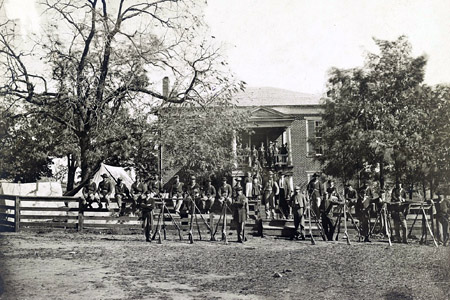 Union troops lounge before (or behind?) the Appomattox County Courthouse in April of 1865, shortly after the surrender: Photo by Timothy H. O'Sullivan, retrieved from the Library of Congress' most excellent website. Union troops lounge before (or behind?) the Appomattox County Courthouse in April of 1865, shortly after the surrender: Photo by Timothy H. O'Sullivan, retrieved from the Library of Congress' most excellent website. |
 |
 The McLean House, where the famous surrender took place. To its left is a keen little smokehouse: Click here to see what it looks like inside! Alternately, you could click here to see a sign about the McLean house on its front gate. The McLean House, where the famous surrender took place. To its left is a keen little smokehouse: Click here to see what it looks like inside! Alternately, you could click here to see a sign about the McLean house on its front gate. |
A fairly standard feature of Virginia's rurally-located courthouses was a low wall of some sort, designed to keep ever-present roving livestock off the courthouse green. The most recognizable remnant of this practice is the remainder of low stone walls around such courthouses as King William, Hanover and many others...but Appomattox went with the less expensive option of a wooden fence, with little two-step barriers at each opening. Two steps was enough to confound a cow or a chicken, but unfortunately not a Yankee soldier. |
The suitably sinister-looking Appomattox County Jail, built in the 1860's or 70's, sits directly to the courthouse's southeast. Like many of the structures standing in Appomattox Courthouse National Historic Park, it is open for casual perusal.
A section of the wall in one of the jail's second-story cells is cut away to show a latticework of iron disappointment for anyone attempting to break out. |
 |
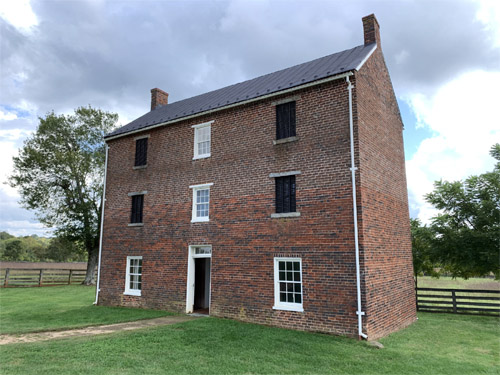 Appomattox County's Old Jail, which went up in the 1860's and/or 1870's. Appomattox County's Old Jail, which went up in the 1860's and/or 1870's. |
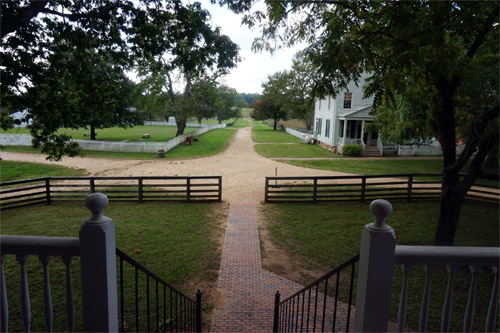 The view from the courthouse's front (back?) door: The McLean house is ahead on the left. The view from the courthouse's front (back?) door: The McLean house is ahead on the left. |
 |
While the Appomattox Court House National Historic Park is a lovely, well-maintained pleasure of a destination, there is zero informational signing about the courthouse itself. This may be because the courthouse serves as the park's Visitor's Center, and there's probably ample info regarding the courthouse in the courthouse, but the Visitor's Center was closed during my visit-in-a-pandemic...plus, the crown jewel of this park's collection is clearly thought to be the McLean House, which is open for guided tours, even during a pandemic. The original Appomattox Courthouse burned down on February 1, 1892, when coals from a fire dropped out of the grate whilst the County Clerk was at dinner. The resulting fire took with it all of the county's records, except for its land tax books: This earns Appomattox County a place on Virginia's prestigious Burned Records Counties list. When a county courthouse burns down there is of course an immediate need for a new county courthouse, but over the preceding 50 years Appomattox County's center of gravity had moved about three miles to the west of Appomattox Court House, thanks to the railroad. County residents voted to move the county seat to Appomattox Depot, which was fittingly renamed Appomattox Court House. |
All of this seems quite reasonable, in that what was thereafter known as Old Appomattox Court House, while a picturesque and charming little village, was isolated and far removed from where the late-19th-century action was. The McLean house was disassembled and shipped to Washington DC in 1893, to be put on display...but for whatever reason this never came to pass, and it was returned to Appomattox and reassembled in the 1940's. The National Park Service reconstructed the original Appomattox County Courthouse in 1964, and the rest, as they say, is history. Click here to see an 1867 map showing Appomattox Courthouse and its environs, which illustrates how close the old county seat is to the present seat, which is marked here as Appomattox St., which assumedly means Station. But the great thing about Appomattox County is that it now essentially has two county seats, at least from the standpoint of a person who has committed to visiting all of Virginia's county seats. Naturally I didn't bother to make myself aware of this before heading in that direction, so I had the pleasure of visiting Appomattox County twice in order to properly chronicle both locations. |
The "New" Courthouse
One of the first things you see when you approach Appomattox County's present courthouse complex is this sign, which tells the story in a succinct fashion:
|
 |
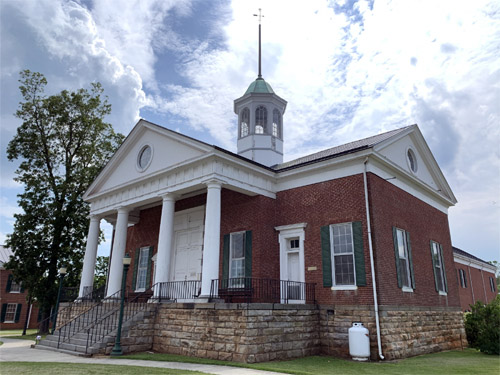 Appomattox County's "new" courthouse, built in 1892. Appomattox County's "new" courthouse, built in 1892. |
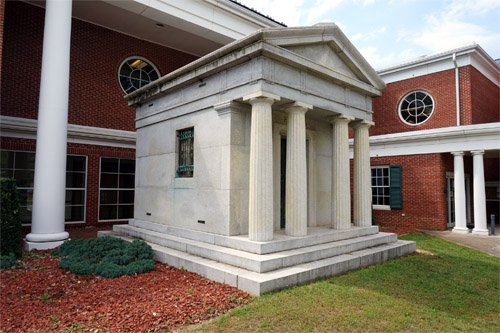 The Flood family mausoleum, unnervingly close to the courthouse. The Flood family mausoleum, unnervingly close to the courthouse. |
 |
Appomattox County's present courthouse complex has just about all that one might desire of the classic Virginia county courthouse cavalcade: Courthouse, jail, clerk's office, Confederate Monument and a low brick wall surrounding it all: But before we get to that stuff, it seems important to talk about a structure that is unique to Appomattox County's courthouse green: The Flood family mausoleum.
Henry D. Flood was born in Appomattox County in 1865, where he would later practice law and then serve as the county's Commonwealth's Attorney. He was elected to Virginia's House of Delegates and then Senate, and concluded his career in the US House of Representatives from Virginia's 10th District. The Flood family was an Appomattox-based political dynasty, which is apparently what it takes to get oneself and one's family eternally interred next to one's courthouse. Flood, his wife and their two infant children reside in the mausoleum, which sits directly to the courthouse's southwest, nestled comfortably in front of a modern courthouse extension. |
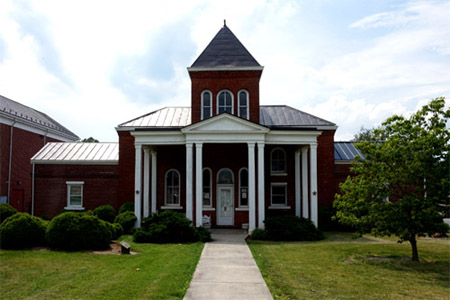 Appomattox County's "New" jail, which is not to be confused with its present jail. This structure is home to the Appomattox County Library and Historical Museum. Appomattox County's "New" jail, which is not to be confused with its present jail. This structure is home to the Appomattox County Library and Historical Museum. |
 |
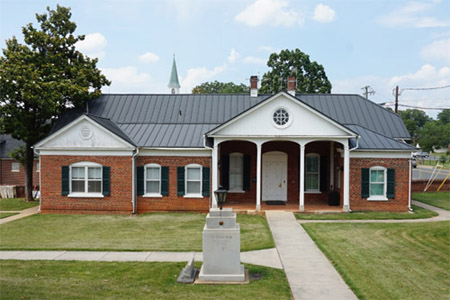 What I would refer to as Appomattox County's "new" clerk's office, only the county never had an "old" clerk's office: If it had, the "old" courthouse might never have burned down. What I would refer to as Appomattox County's "new" clerk's office, only the county never had an "old" clerk's office: If it had, the "old" courthouse might never have burned down. |
The Confederate Monument on Appomattox County's courthouse green was erected in 1905, and is of a fairly common design: An obelisk with a life-sized, slouch-hatted soldier atop. The names that were notionally inscribed on the tablets on each of the monument's sides are illegible thanks to the passage of time, but a new stone was added in 2000, listing the local units that fought for the Confederacy. My visit to Appomattox Courthouse was at the start of June 2020, at which time some of Richmond's monuments to the Confederacy (and also that noted Confederate stalwart, Christopher Columbus) had recently been removed and/or destroyed. In light of this, Appomattox County had increased the level of security around its monument: There were already a pair of artillery pieces flanking it, but half a dozen plastic road construction barriers had been added as well. Behind the Confederate Monument is a small but dignified monument commemorating those of Appomattox County who died in the " other wars": World War I, World War II, the Korean War (with an additional footer added in honor of Charles Thomas Moses, Jr.), and the Vietnam War are represented...and yet another plaque lies before it. |
 |
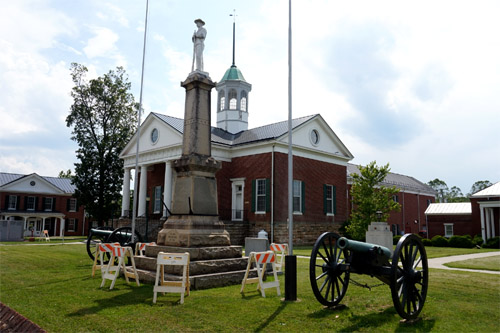 Appomattox County's Confederate Monument, behind an impenetrable barrier. Appomattox County's Confederate Monument, behind an impenetrable barrier. |
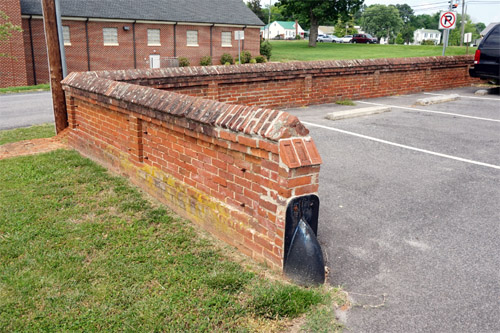 The conclusion of the low wall around the "new" courthouse, at its northernmost extent. Note the cool little iron bumper or wall cap at the bottom. An excellent idea if you're planning on having automotive traffic blundering around in the vicinity! The conclusion of the low wall around the "new" courthouse, at its northernmost extent. Note the cool little iron bumper or wall cap at the bottom. An excellent idea if you're planning on having automotive traffic blundering around in the vicinity! |
 |
At the very least, a Virginia courthouse needs to have two things to make it look like a Virginia courthouse: Columns, and a low brick surrounding wall. Appomattox County's new courthouse has both of these entities in play. One imagines that the Appomattox Depot of the turn of the futuristic 20th century didn't have a whole lot in the way of loose livestock barging into places, as would have been the case in the rural location of the county's original courthouse...which is what such a low wall was designed to prevent. But, image is important. Even more monuments on the courthouse green, these seeming to be dedicated to both First Responders, and local businesses and folks who were willing to cough up the dough to be included. |
|
 |
|



